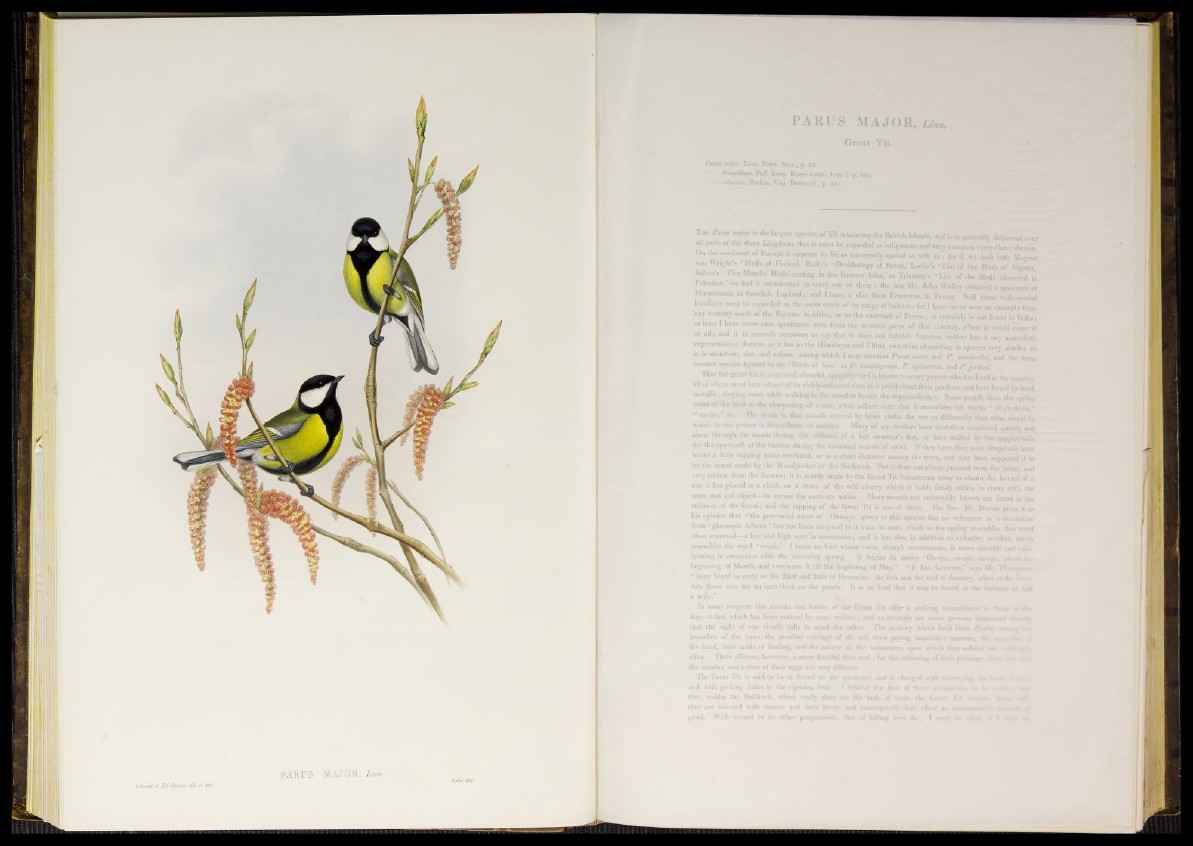
P A R U S M A JO H , L u
J.GauU/ & S.CJluhter, cliL tb Mu
PARUS MAJOR, Lùm.
Great Tit.
Pants major, Linn. Eaun. Suec.,p. 96.
fringillago, Pall. Zoog, Ross.-Asiat., tom. i. p. ,
robustus, Brehm, Vog. Deutschl., p. 461.
T h e Pams major is the largest species o f Tit inhabiting the British Islands, and is so generally dispersed over
all parts of the three Kingdoms that it must be regarded as indigenous and very common everywhere therein
On the continent of Europe it appears to he as universally spread as with u s for if we look into Magnus
von Wright’s ‘ Birds o f Finland,’ Bailly’s ‘ Ornithology of Savoy,’ Loche’s ■ List o f the Birds o f Algeria,’
Salvin’s ‘ Five Months’ Birds’-nesting in the Eastern Atlas,’ or Tristram’s • L ist of the Birds observed in
Palestine,’ we find it enumerated in every one o f them ; the late Mr. John Wolley obtained a specimen at
Muoniovara, in. Swedish Lapland; and I have a skin from Erzeroum, in Persia. Still these widespread
localities must be regarded as the outer circle o f its range of hab itat; fo r i have never seen an example from
any country south o f the Equator in Africa, or to the eastward o f Persia ; it certainly is not found in In d ia;
a t least I have never seen specimens even from the western parts of that country, where it would occur if
at all; and it is scarcely necessary to say that it does not inhabit America, neither has it any immediate
representative therein, as it has in the Himalayas and China, countries abounding in species very similar to
it in structure, size, and colour, among which I may mention Parus minor and /*. monticolas■, and the three
crested species figured in my ' Birds o f Asia ’ as P . .rantltogemjs, P. spilonotus, and P.jerdoni.
Th a t the great T it i r iBterrffuull,M spr)ightly bird is known to every person who has lived iu the c
all o f whom must have observed its ricbly-eabured tints as it pried about their gardens, and Imve heard its loud,
metallic, ringing voice while walking in the wood or beside the coppice-hedge. Some people liken the spring
notes o f the bird to the sharpening of a saw, while others state that it resembles the words ** sit-ye-down,"
“ ox-eye,” Ac. The truth is, that sounds uttered by birds strike the ear so differently that what would be
music to one person is discordance to another. Many o f my readers have doubtless sauntered quietly and
alone through the woods daring the «illness o f a hot summer’s day, o r have waited by the coppice-side
for the approach o f the beaters during the autumnal season o f sport. I f they have, they must frequently have
heard a little tapping noise overhead, or a t a short distance among the trees, and may have supposed it to
be the sound made by the Woodpecker o r the Nuthatch. But it does not always proceed from the latter, and
very seldom from the fo rm er; it is mostly made by the Great T it hammering away to obtain the kernel o f a
nut it has placed in, a chink, o r a stone o f the wild cherry which it holds firmly within its claws with the
same end and object to secure the contents within. Many sounds not universally known are heard iu the
stillness o f the forest; and the tapping o f the Great T it is one o f them. The Rev. Mr. Morris gives it as
his opinion that “ the provincial name o f * Oxe-eye * given to this species has no reference to a derivation
from ‘ glaucopis Athene,’ but has been assigned to it from its note, which in the spring resembles this word
often repeated—a low and high note in succession; and it has also, in addition to a chatter, another, which
resembles the word * twink.’ I know no bird whose voice, thongh monotonous, is more cheerful and exhilarating
in connexion with the returning spring. It begins its merry ‘ Ox-eye, ox-eye, ox-eye,’ about i!,,-
beginning o f March, and continues it till the beginning o f May,” “ It has, however,” says Mr. Thompson
“ been beard as early as the 23rd and 24th o f December, the 5th and the end o f .January, when at the latter
date there was ice an inch thick on the ponds. It is so loud that it may be beard at the distance of halt'
a mile.”
In many respects the actions and habits o f the Great Tit offer a striking resemblance to those o f the
Jay—a fact which has been noticed by most writers; and so strongly are some persons impressed therein
that the sight o f one vividly calls to mind the other. The activity which both birds d*snlav among ib
branches o f the trees, the peculiar carriage o f the Util, their prying inquisitive manners, the re tra c t* « »
the head, their mode of feeding, and the nature of the substances upon which they subsist a re - a ;
alike. Their alliance, however, is more fanciful than re a l; for the colouring of their plumage, the»? >w. **»
the number and colour o f their eggs are very different.
The Great T it is said to be no friend to the
rdener, and is charged with
and with picking holes in the ripening fruit,
telieve the first o f these act
that, unlike the Bullfinch, which really does
the buds o f trees, the Gm
that are infested with insects and their larva?
iid consequently does effect i
good. With regard to its other propensities,
J
I